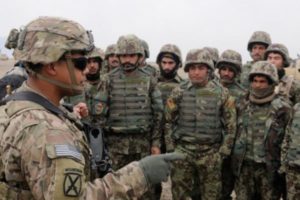by WorldTribune Staff, March 24, 2017
The United States and the Afghan army it is training plan to drive the Islamic State (ISIS) affiliate out of Afghanistan this year, U.S. military officials said.
Islamic State Khorasan Province (ISIS-K), based near the Afghan-Pakistan border, has increased its recruiting and the number of terror attacks it has carried out in Afghanistan. The group claimed responsibility for a March 8 attack on a military hospital in Kabul that killed at least 31 people.

“Our goal in 2017 is to defeat ISIS-K in Afghanistan,” U.S. Navy Capt. Bill Salvin, the spokesperson and director of public affairs for Resolute Support headquarters in Kabul, told Voice of America’s Afghan service.
NATO and the Afghan government say they have significantly reduced ISIS-K’s numbers and their territorial control from more than 10 districts to fewer than five.
“In 2016, we believed that year began with about 3,000 or so ISIS-K members in about 12 districts in southern Nangarhar,” Salvin said. “Right now, we believe there are about 600 ISIS-K members in two or three districts in southern Nangarhar.”
Still, ISIS-K has “shown an ability to conduct attacks in Kabul and elsewhere in the country,” Gen. John Nicholson, the top U.S. military commander in Afghanistan, told the Senate Armed Services Committee.
Analysts say that U.S. and Afghan officials may be overly optimistic about containing ISIS’s influence in Afghanistan.
“Ultimately, we should applaud U.S. efforts to cut down the presence of ISIS fighters in Afghanistan,” said Michael Kugelman, a South Asia specialist at the Woodrow Wilson Center in Washington. “But the broader problem is the ideologies of hate that keep ISIS strong. Taking aim at the ideological drivers of ISIS will be very difficult.”
“The Afghanistan-Pakistan region is a magnet for militancy, and there’s no reason why the hundreds of ISIS fighters that have been lost won’t be replaced,” Kugelman said. “There are deeper issues that need to be addressed — such as why ISIS managed to develop a presence in Afghanistan in the first place — and these are issues that can’t be addressed by the U.S. military.”
Salvin said American forces in Afghanistan, which number about 8,400, are pursuing a two-pronged approach to combating ISIS.
“The first is the unilateral U.S. counterterrorism mission called Operation Freedom, and that is where we will conduct the operations against terrorist groups like ISIS-K on our own,” he said. “The other way that we are attacking ISIS-K is in partnered operations with the Afghan special forces. They have had a great success in fighting ISIS-K, especially over the last month or so.”
Salvin predicts bolstered Afghan forces ultimately will win the fight.
“We believe that they are stronger going into 2017 than they were when they finished 2016,” Salvin said. “So while we do believe it will be a challenging year, we believe that the Afghan forces will be successful, and we will be here to be their partners.”
